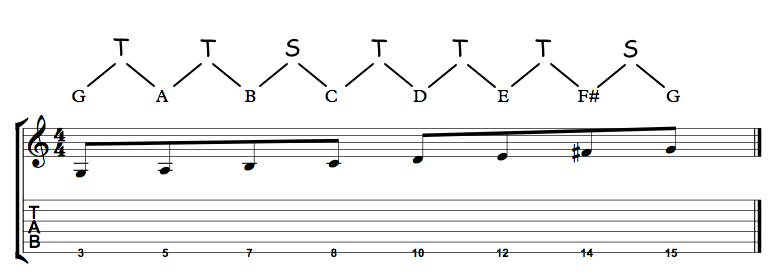
I have written extensively on this site about scales. Scales form the basis for a whole range of music theory, from building chords, to composition, to soloing.
They are very important.
What we’re going to do in this lesson is explore the concept of scales, and use our knowledge of intervals and the fretboard to construct them. If you’re unfamiliar with the concept of intervals, read the lessons in the links above.
What Is A Scale?
You can think of a scale as a group of notes separated by intervals. Each scale has a unique sequence of intervals. Once we know what the sequence of intervals is for a particular scale, we can easily play that scale. In the lesson on basic intervals, we learnt about tones and semitones. In a nutshell, a semitone is an interval of one fret, and a tone is an interval of two frets. Once you are familiar with tones and semitones, you can use them to build scales, by knowing what the interval structure of a particular scale is.
The Major Scale
Let’s look at the interval structure of the major scale. What that means is that we are going to look at the sequence of intervals that makes up the major scale.
Tone – Tone – Semitone – Tone – Tone – Tone – Semitone
That’s all it is.
If we play that set of intervals from start to finish, we end up playing the major scale. Of course, doing examples is the best way to put this to the test.
Playing Scales On 1 String
A great way to really get a feel for how scales work is to play the scale on one string. Playing a scale on one string allows you to really see the intervals, as you are playing them, which makes it a great starting point. In fact, usually when we play scales, we don’t confine the notes to one string, but it is a great way to get started and learn about scales.
Let’s look at the major scale again, using ‘S’ to represent a semitone, and ‘T’ to represent a tone.
T – T – S – T – T – T – S
Think of that sequence as a set of instructions. The first step is to select a starting note. It can be anything. The starting note becomes what is known as the ‘root note’. Once you have a starting note, you move up a tone, then another tone, then a semitone, then a tone, then another tone, then another tone, then a semitone. The last step of scale takes you back to the original starting note (up one octave).
Let’s do an example. The 3rd fret of the 6th string is the note ‘G’. If we started from this note (therefor making it the root note of the scale), we would be playing a ‘G major scale’. It would look like this:

Play the above example yourself, to really get a feel for what’s happening. Let’s do another example. This time we will start on the 4th fret of the 3rd string. Since that note is ‘B’, we will be playing a ‘B major scale’.

In the two examples that we have done so far, we have played the scale over one octave, ascending. That means that we have started from a root note, played through the notes in the scale in an upwards direction (pitch-wise), and then finished on the root note again (up one octave).
We can also play the scale descending, which means we basically go back down the way we came. The sequence of intervals are reversed when descending through a scale. Observe the following C major scale, ascending and descending:

Of course, do a few more. Simply pick a starting note on any fret and any string and move up using the sequence of intervals that make up the major scale.
Other Scales
The major scale is most important scale to learn, which is why we have focused on it, but of course, there are many other scales which each have their own interval structure. Let’s look at a few more scales for example. Before we do, let’s introduce a new interval.
Minor 3rd (m3) = 3 semitones.
The next few example scales include intervals of minor 3rds.
Let’s look at the ‘minor pentatonic scale‘. The minor pentatonic scale is made up of the following intervals:
b3 – T – T – b3 -T
Just like we did with the major scale, we can easily explore the scale by playing the sequence of intervals on one string. Let’s play the ‘C minor pentatonic scale‘ by starting on the 3rd fret of the 5th string.

Now for another scale. The ‘major pentatonic scale’ is made up of the following sequence of intervals:
T – T – m3 – T – m3
Let’s play the C Major pentatonic scale using the same starting position that we used for the C minor pentatonic scale:

Playing Scales In Positions
By now you should have a good understanding of how to play scales on one string, provided that you know the interval sequence that makes up a given scale. As I said, playing scales on one string is a great simple way to familiarise yourself with a new scale. It allows you to really see the intervals and accustom yourself with the sound of the scale before you start putting it to use.
In reality though, we rarely play scales using only one string, once we have learnt them. What we do is organise them in positions. I have already written a lesson on playing scales in positions, so I recommend reading that lesson.
What’s The Point Of Scales?
So we’ve figured out how to play scales, using intervals, but we haven’t really touched on the purpose of scales. Why do we learn them? How can we use them?
Well, that’s for the next lesson. The purpose of this lesson is for you to become familiar with the concept of scales as a sequence of intervals. Still, there is quite a bit of information about scales on this site already, so if you want to know more, check out the following resources.
Further Reading
- Scales Page – This is the scales page of this site. You will find links to many different scales in different keys.
- The CAGED System and the Importance of 5 Positions – A lesson about playing scales in 5 different positions.
- How to Read Scale Diagrams – Usually, we use scale diagrams to learn new scales.
- Playing scales by staying in one position – A good approach to playing scales.
